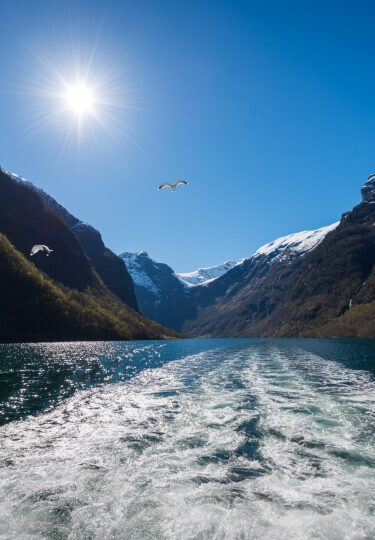With jagged mountains, pounding waterfalls, and calm waters, Norway’s fjords are part of an impossibly beautiful landscape in northwest Europe.
Norway’s fjords are long and deep channels, often with many smaller branches—referred to as “arms”—reaching deeper into the landscape. The dramatic Geirangerfjord, for example, is a tributary of the Sunnylvsfjorden, which is an arm of the Storfjorden.
Here are some of the best fjords to see in Norway.
Geirangerfjord
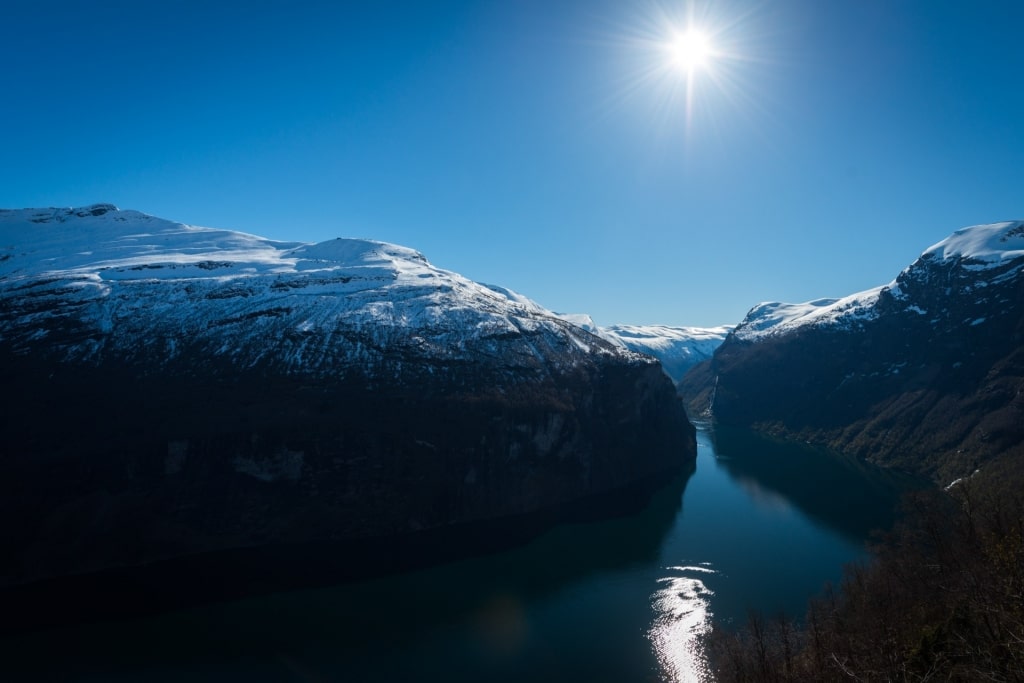
Geirangerfjord
One of the most beautiful places in Norway, the UNESCO-listed Geirangerfjord spans nine and a half miles at the innermost point of the Storfjorden, with the hamlet of Geiranger at the fjord’s tip.
There’s a kayak center in the village for guided tours of the glassy fjord. Few Norway fjords experiences compare to paddling in the water to the Geirangerfjord’s Seven Sisters waterfalls. Pack your camera in a waterproof case to capture the cascade tumbling 820 feet into the fjord.
Travelers could also experience a leisurely boat ride, a high-speed rigid inflatable boat (RIB) tour, or an exhilarating canoe trip.
Geirangerfjord is laced with hiking trails offering scenic views of the glistening fjord, including the Fosseråsa route. It’s signposted from the center of Geiranger to Storsæterfossen, one of Norway’s beautiful waterfalls. The route takes up to two hours return, depending on your pace.
For some of the most incredible views of the snowy and pastoral landscapes around Geirangerfjord make your way to Geiranger Skywalk viewing point—almost 5,000 feet above the sea—at Dalsnibba. Opened in 2016, Geiranger Skywalk seemingly floats in the sky, high above the fjord.
Lysefjord
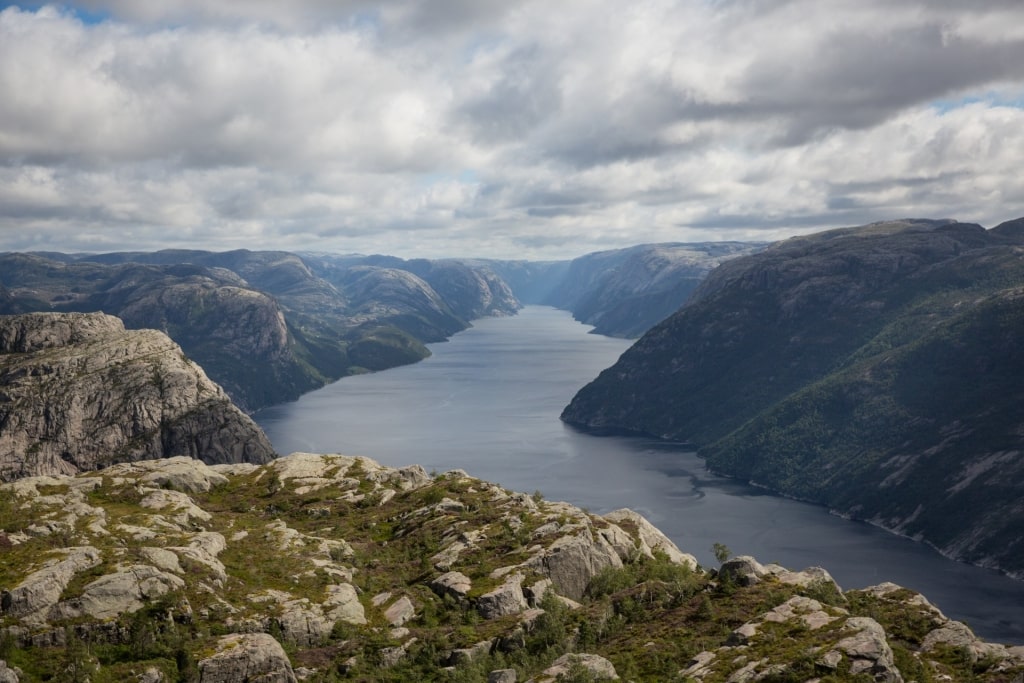
Lysefjord
One of the best things to do in Stavanger is to take a day trip to Lysefjord, famed as the home of Preikestolen, or Pulpit Rock, in Ryfylke.
Towering almost 2,000 feet above the sapphire-blue fjord, Preikestolen is a leaden-hued rock formation with a massive flat-top ledge. Travelers can reach the top to take in the far-reaching views on one of Norway’s most famous hikes.
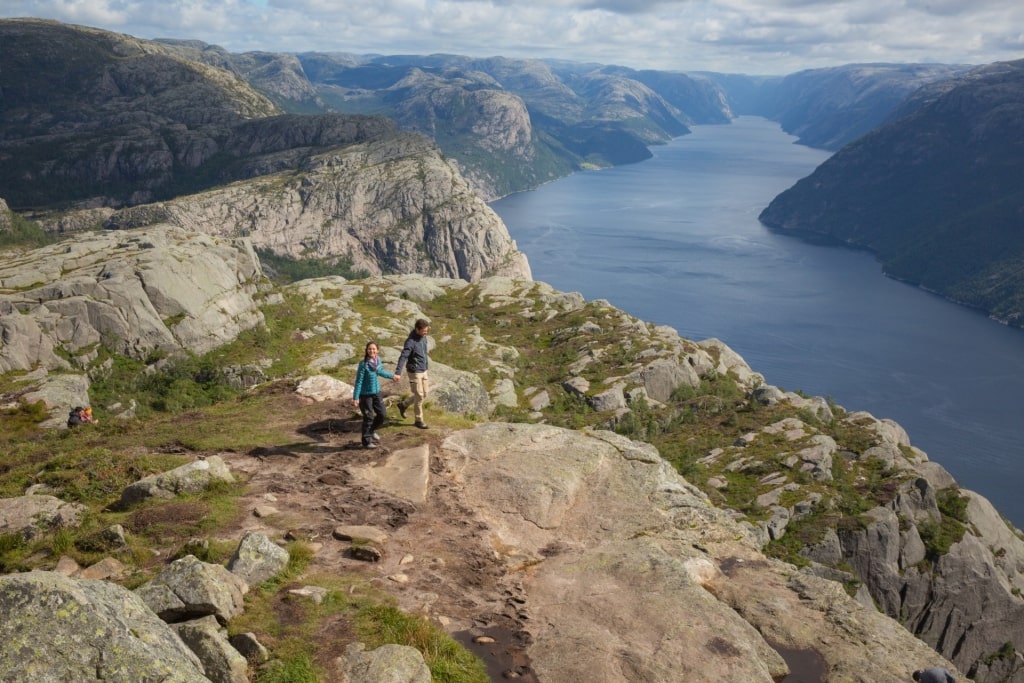
Pulpit Rock
The five-mile round trip starts at Preikestolen Fjellstue mountain lodge. It’s a demanding trek, but well worth it for the cinematic views that Norway is known for. As with any hike in Norway, wear suitable clothing and boots with a good grip.
The 26-mile Lysefjord can also be enjoyed via a fjord cruise from Stavanger, which takes around three and a half hours. This sedate trip offers the chance to see Preikestolen from the water and feel the spray of the fan-tailed Hengjanefossen waterfall.
Nærøyfjord
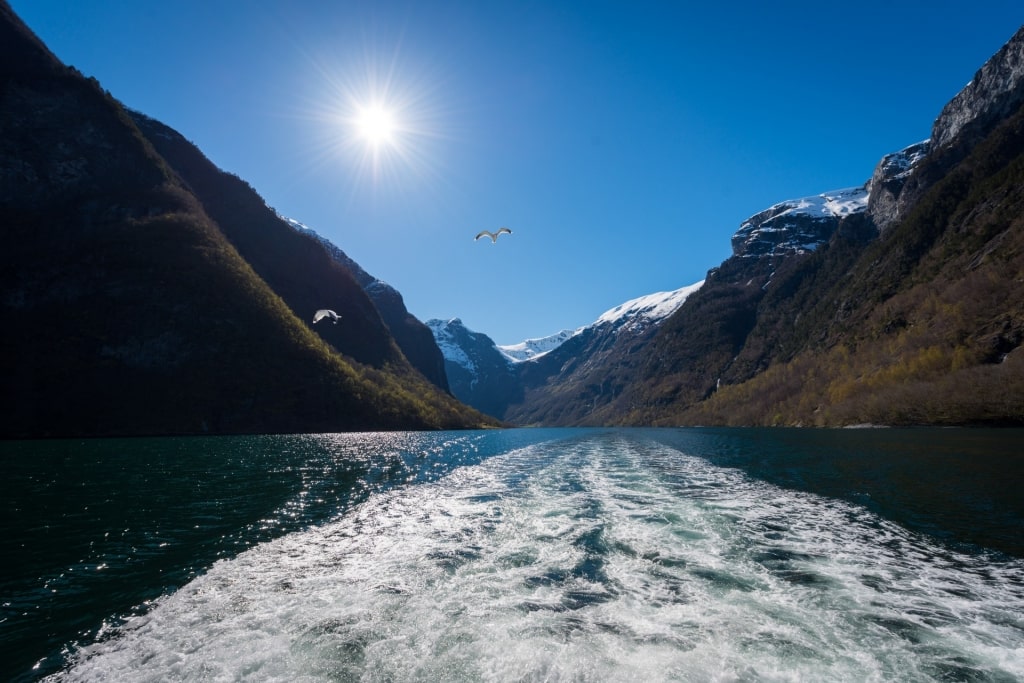
Nærøyfjord
Another UNESCO-listed Norway fjord, Nærøyfjord is a spectacular arm of the Sognefjord. At ten and a half miles long and just 820 feet at its narrowest point, Nærøyfjord is small in size but big on drama, and sailing along here is one of the best things to do in Norway.
Rousing green-covered mountains loom over Nærøyfjord, while the attractive village of Bakka and its good-looking white timber church sits on the fjord’s west shore.
The Nærøydalselva River empties into the fjord at Gudvangen, at the inner point of Nærøyfjord. Here, travelers can explore Njardarheimr, a Viking village that mirrors life 1,000 years ago.
Tour Viking long houses and boat houses, and gain a deeper sense of how Vikings traveled, lived, and worked during a 45-minute tour.
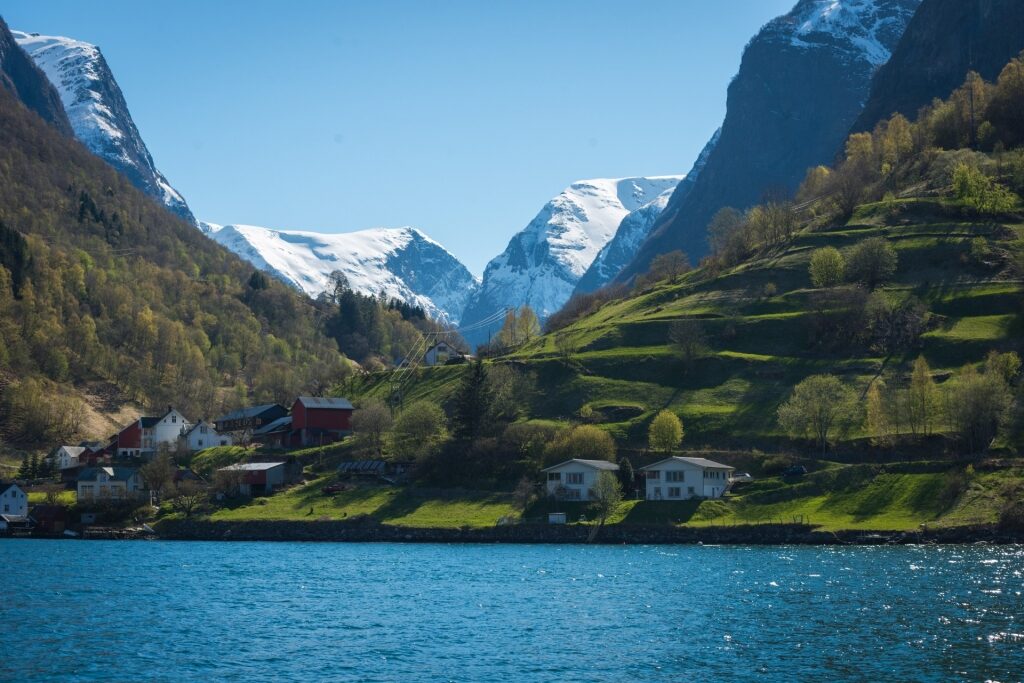
Flåm
If you’re more invested in soaking up the mountain scenery, there’s a boat service from Gudvangen to Flåm, or vice versa, on the parallel fjord, while the Rimstigen path offers a glorious hike through forests, past farms, and waterfalls.
Aurlandsfjord
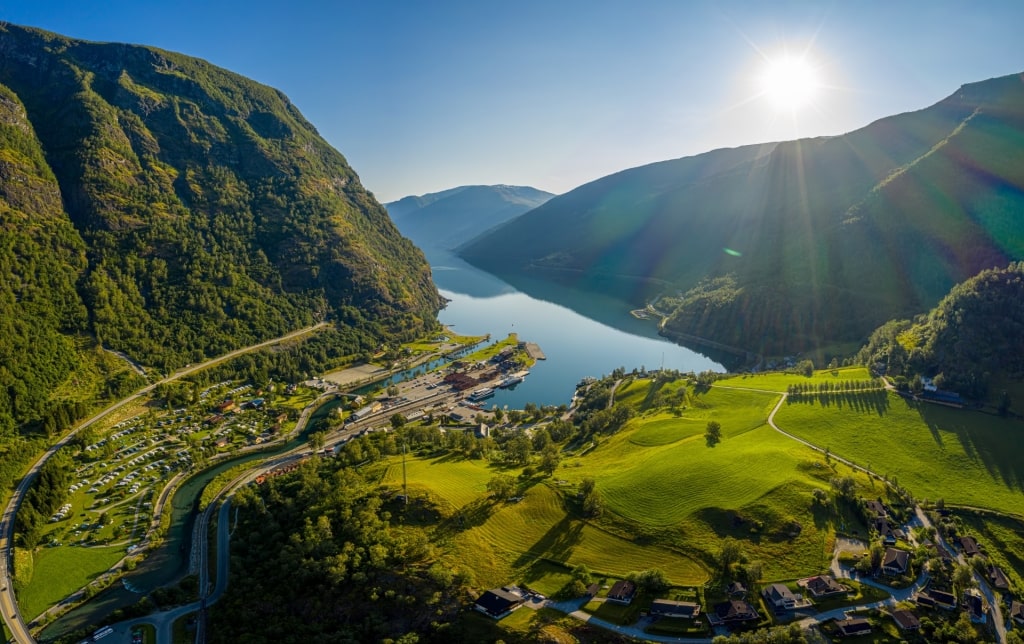
Aurlandsfjord
The Aurlandsfjord is as pretty as its neighbor, Nærøyfjord. Branching off Norway’s longest fjord, the Sognefjord, three villages lie on Aurlandsfjord: Undredal, Aurlandsvangen, and Flåm.
Travel to the Stegastein Viewpoint, reached via a zigzagging road from Aurlandsvangen, on the east side of the fjord. The road leads up the mountainside some 2,000 feet, with a viewing platform hovering among the green treetops.

Flåm Railway
A 10-minute drive south of Aurlandsvangen, Flåm lies at Aurlandsfjord’s innermost point. Here, the Flåm Railway traverses through the lush valley to reach Myrdal station, 2,844 feet above sea level.
A ride on the Flåm Railway is a two-hour round trip and is one of the most scenic railway journeys in the world. If you haven’t ridden it before, it’s a must-do.
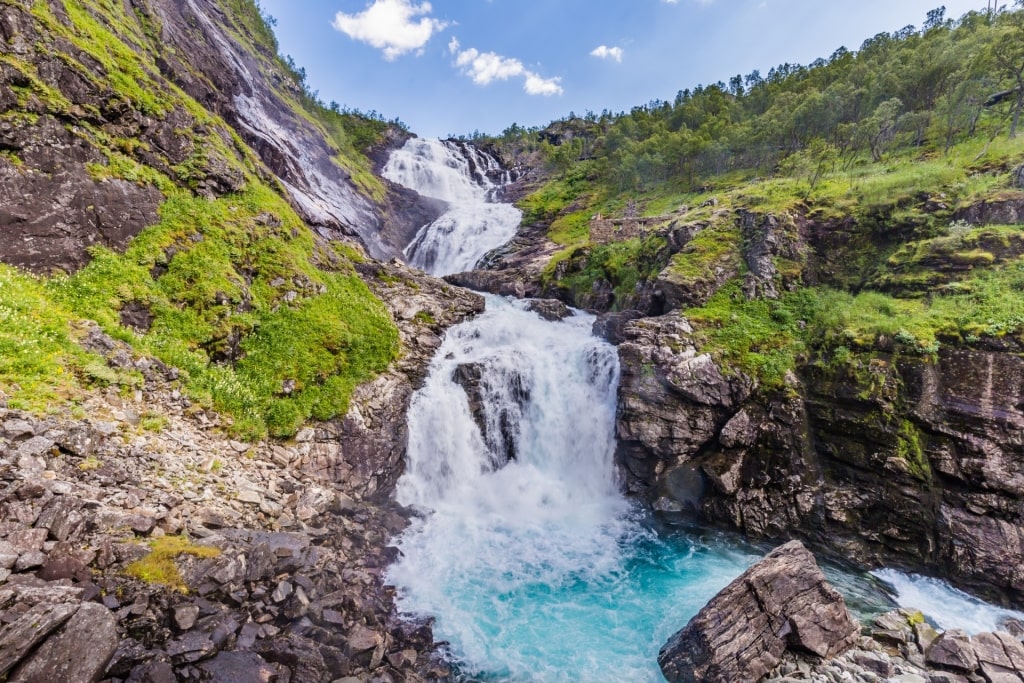
Kjosfossen Falls
The steep line travels through 20 tunnels, passes the handsome Flåm Church, and stops at the beautiful Kjosfossen Falls, where passengers can hop off. Enjoy the embrace of the waterfall’s fine mist, while stopping for a photo before stepping back inside the pine-green carriages.
Back in Flåm, explore the history of the prized railway at the Railway Museum. There’s a village bakery for fresh bakes and coffee, the fish market for warming seafood soup, and the cozy Ægir microbrewery for craft ales.
Read: Norwegian Food Guide
Innvikfjorden
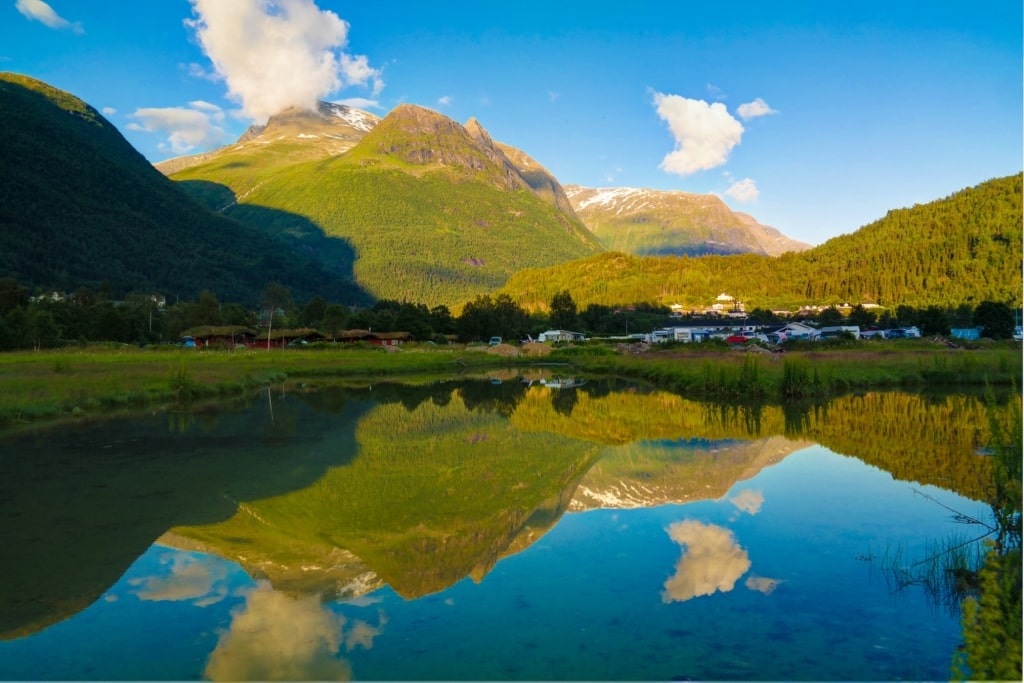
Innvikfjorden
The sweeping Innvikfjorden is another extraordinary Norway fjord, close to the mighty Jostedalsbreen National Park, mainland Europe’s largest glacier.
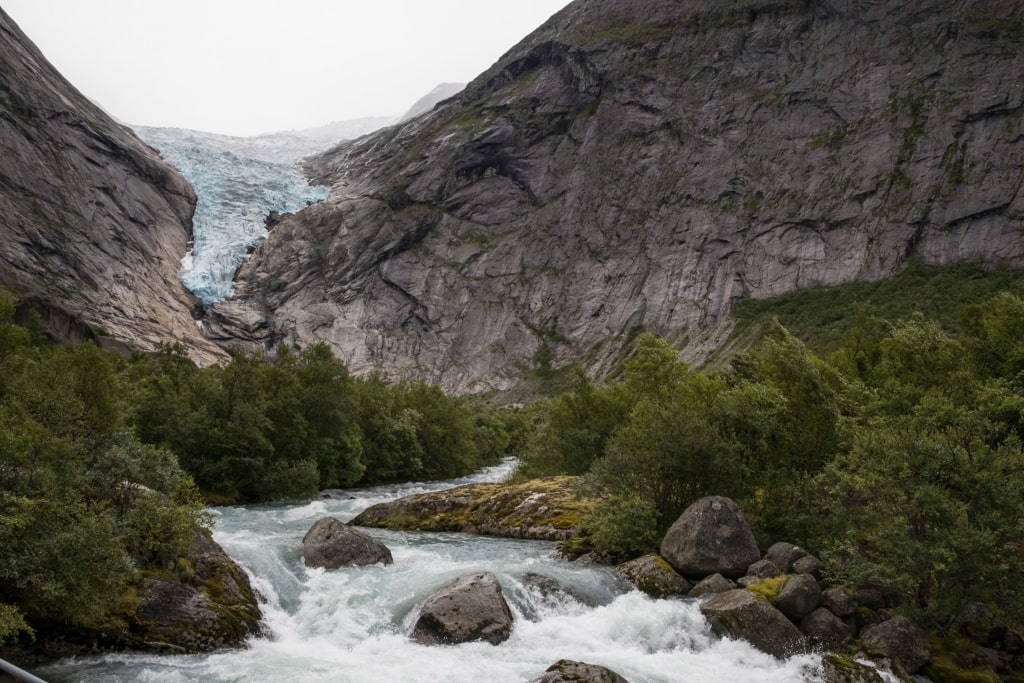
Briksdal Glacier
Intrepid travelers can venture to the ice-blue Briksdal Glacier, an arm of Jostedalsbreen that’s reached via a moderate-level hike through pine forests and by waterfalls.
The dazzling route covers around two miles and takes up to two hours on foot, roundtrip. There’s also a troll car, taking around 90 minutes roundtrip.
In Loen, a few miles north of Olden, opt to scale Mount Hoven via the Loen Skylift for a breathtaking ride toward the clouds. The cable car is one of the sharpest in the world, reaching a height of 3,317 feet.
At the summit, there’s a zipline that whizzes across the upper section of the Tungejølet gorge, high above the fjord.
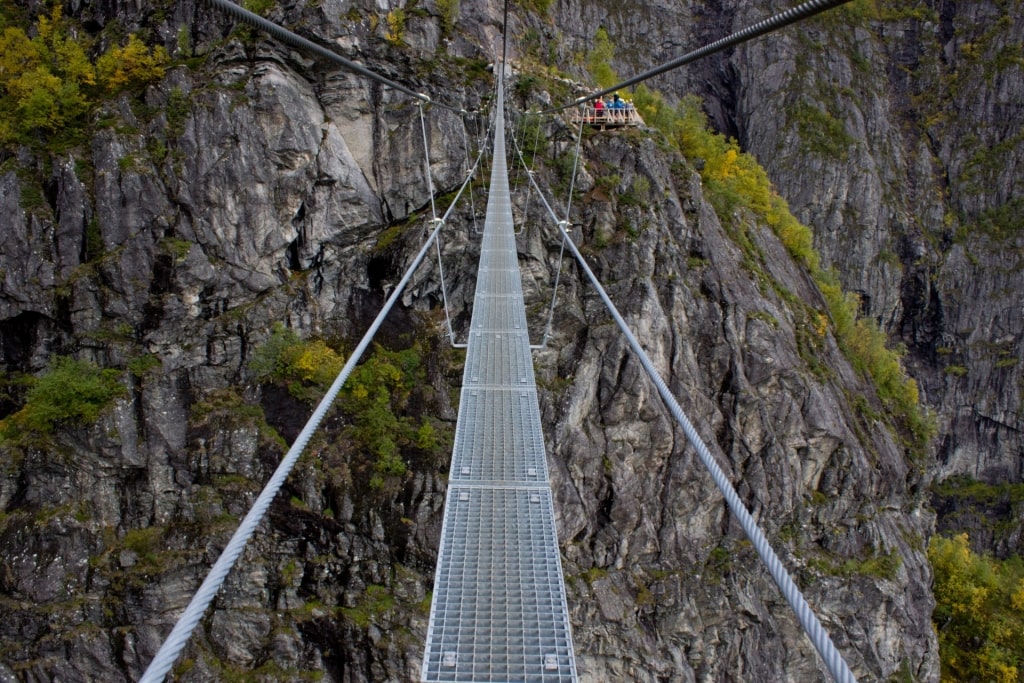
Via Ferrata Loen
More experienced hikers and climbers might want to tackle the Via Ferrata Loen. This difficult climbing route sees participants secured by a wire to cross the narrow Gjølmunnebrua, Europe’s longest via ferrata bridge, 2,460 feet above the sea.
The views of Innvikfjorden and the surrounding Norwegian mountains—Lodalen, Oldedalen, and Skåla—are magnificent.
A more relaxing way to enjoy the views is from Hoven Restaurant, next to Loen Skylift, where a charcuterie platter, venison stew, and a salmon or veggie burger are among the pleasing dishes.
Hardangerfjord
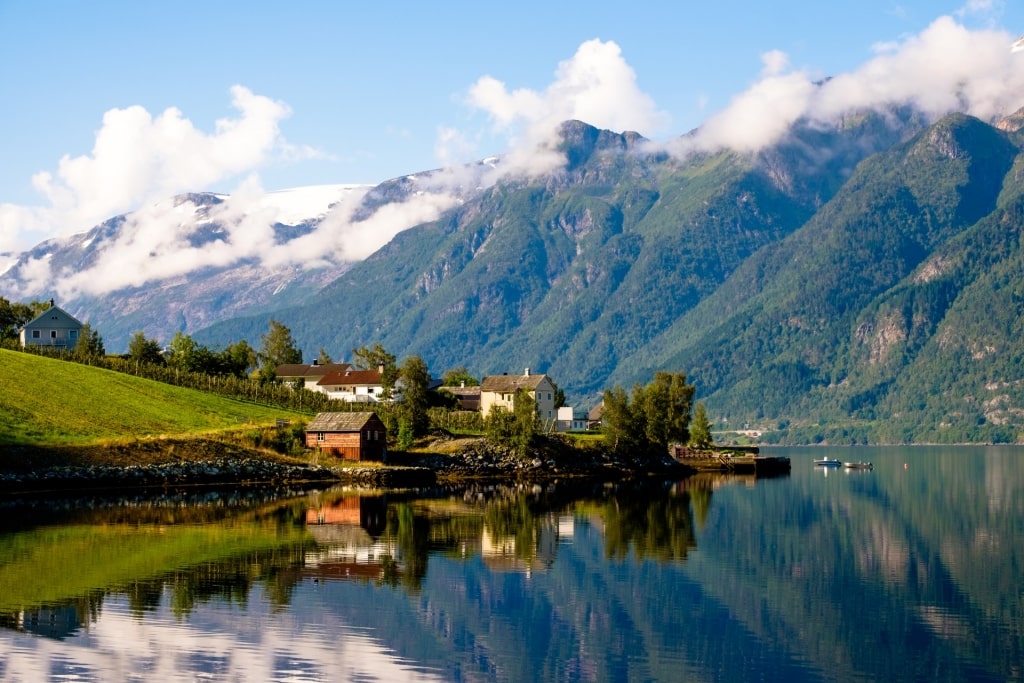
Hardangerfjord
Hardangerfjord is the second-largest fjord in Norway, spanning 111 miles, roughly a 90-minute drive south of Bergen, on the country’s serrated fjord coastline.
Norheimsund is a notable village on Hardangerfjord, with a pretty waterfront with a wide-open grassy promenade dotted with silver birch trees on the fjord’s north shore.
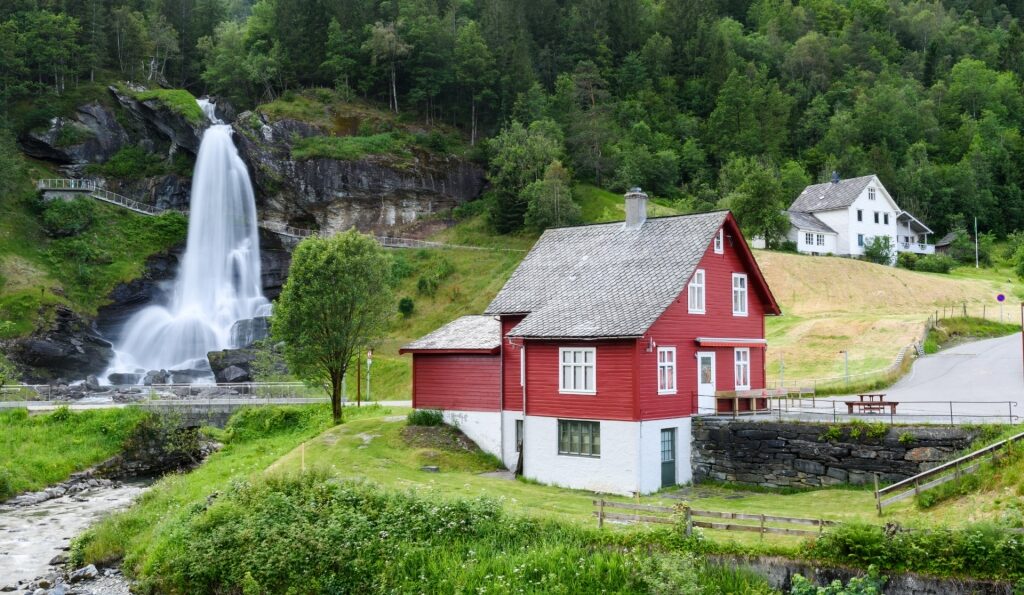
Steinsdalsfossen
Traditional clapboard buildings line the harbor, where the Hardanger Maritime Center is located. This fascinating maritime museum offers ropemaking and wooden-boat-building activities. After, tag on a visit to Steinsdalsfossen, a powerful waterfall on the Fosselva River where a foot trail leads behind the veil of water.
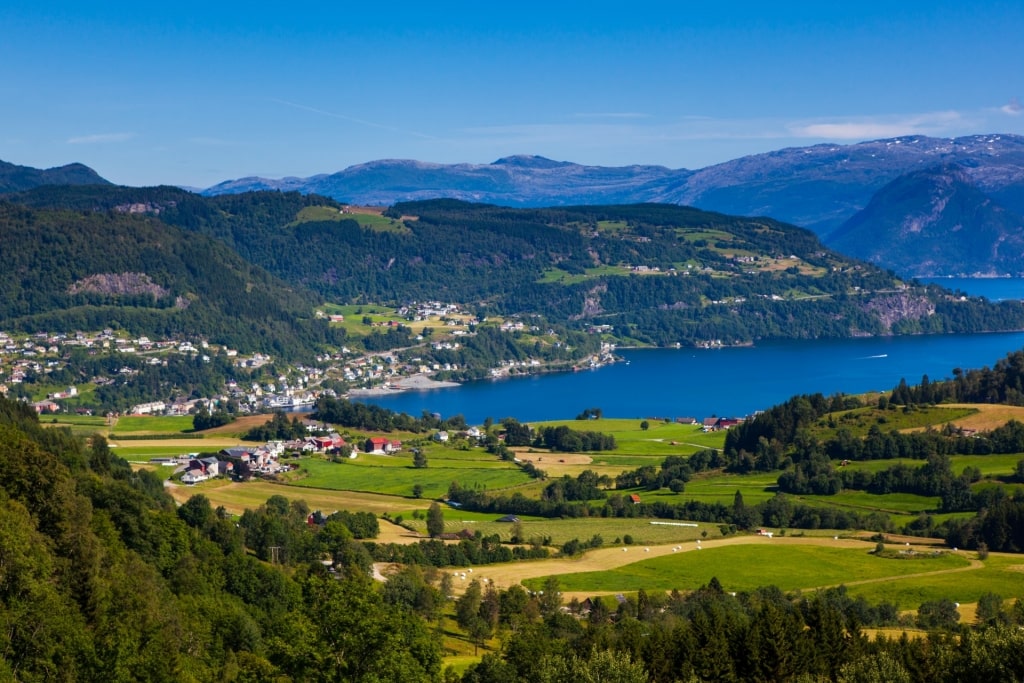
Hardanger
With marvelous apple orchards blooming around Hardangerfjord’s verdant slopes, apple juice and apple cider are among the popular local libations.
On the edge of the fjord, just outside of Norheimsund, stop by the idyllic Steinstø Fruit Farm, a ninth-generation producer of strawberries, raspberries, cherries, plums, apples, and pears.
There’s a restaurant and shop where visitors can pick up produce, including cider, jams, and jellies.
Read: Best Things to Do in Bergen
Nordfjord
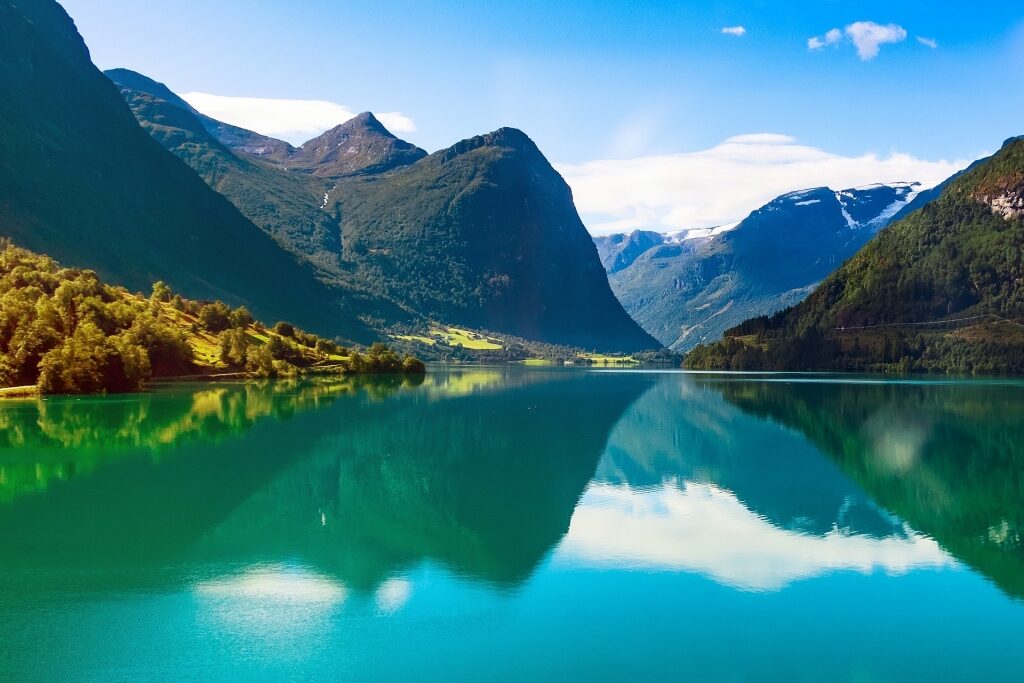
Nordfjord
The 66-mile Nordfjord is among the largest fjords in Norway. Featuring several smaller arms, Nordfjord weaves from the islands of Vågsøy, Bremangerlandet, and Husevågøy on the wild North Atlantic coast to Loen, on the Innvikfjorden.
Nordfjord lies near Hornindalsvatn—the deepest lake in Europe—which flows into the River Eidselva and empties into the Nordfjord at Nordfjordeid, a former Viking settlement and one of the larger towns on the Nordfjord.
Factor in a visit to Sagastad Viking Center. It’s the location of the extraordinary Myklebust, a 98-foot Viking ship, the largest ever discovered in Norway, found in 1874. Sagastad is a great place to learn more about Viking culture, with exhibitions, a cinema, and a virtual reality experience.
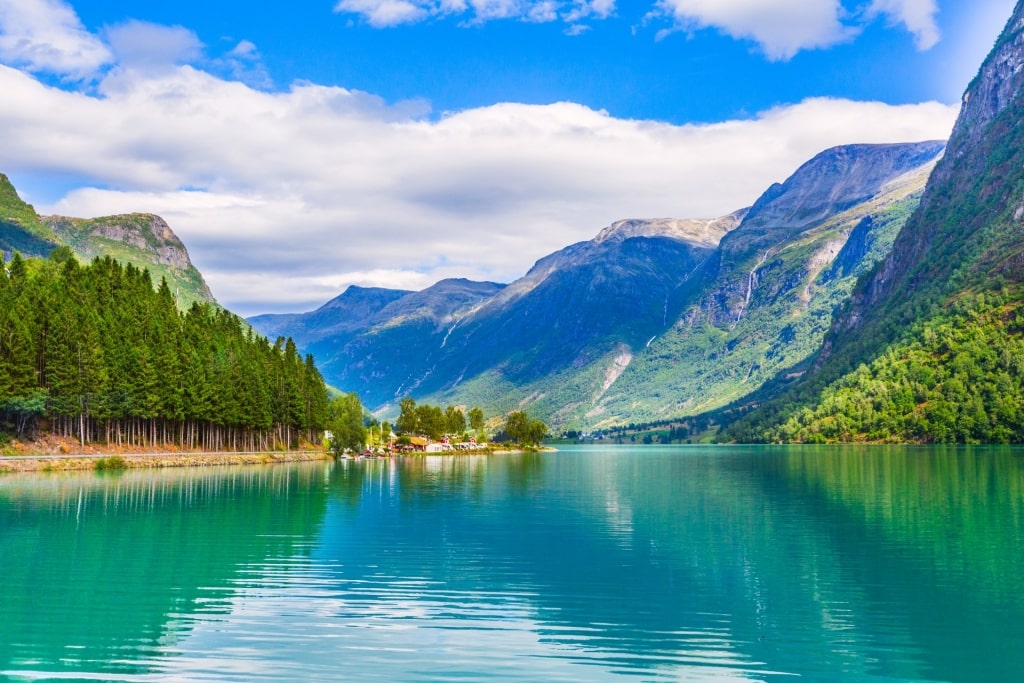
Nordfjord
Swimming, kayaking, and hiking, are all popular nature-led activities on the Nordfjord. Horseback riding is popular, too, with Nordfjord famous for its mild-mannered fjord horses, one of the world’s oldest horse breeds.
These beautiful creatures range from creamy coffee color to bronze and graze on the wildflowers and grass around the fjord. Equestrian experiences, including horseback riding and meeting the horses, are offered at the Norwegian Fjord Horse Center in Nordfjordeid.
Romsdalsfjord
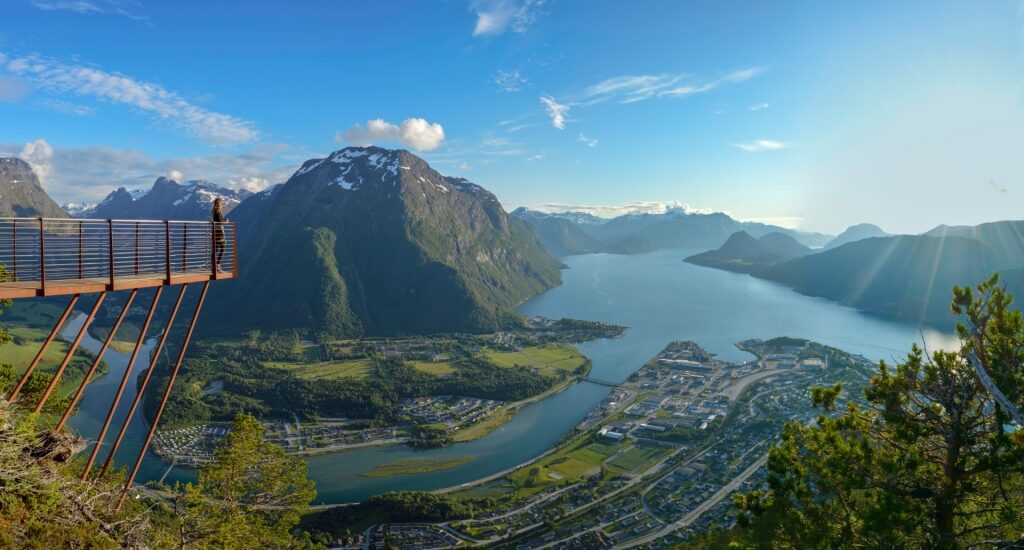
Romsdalsfjord
Picturesque Romsdalsfjord lies south of Molde in western Norway, with several outlying islands separating the fjord from the Atlantic Ocean.
The 55-mile-long fjord features the town of Åndalsnes in the Romsdalen Valley on its south shore, and the village of Isfjorden at its innermost tip—both boasting a delicious alpine backdrop.
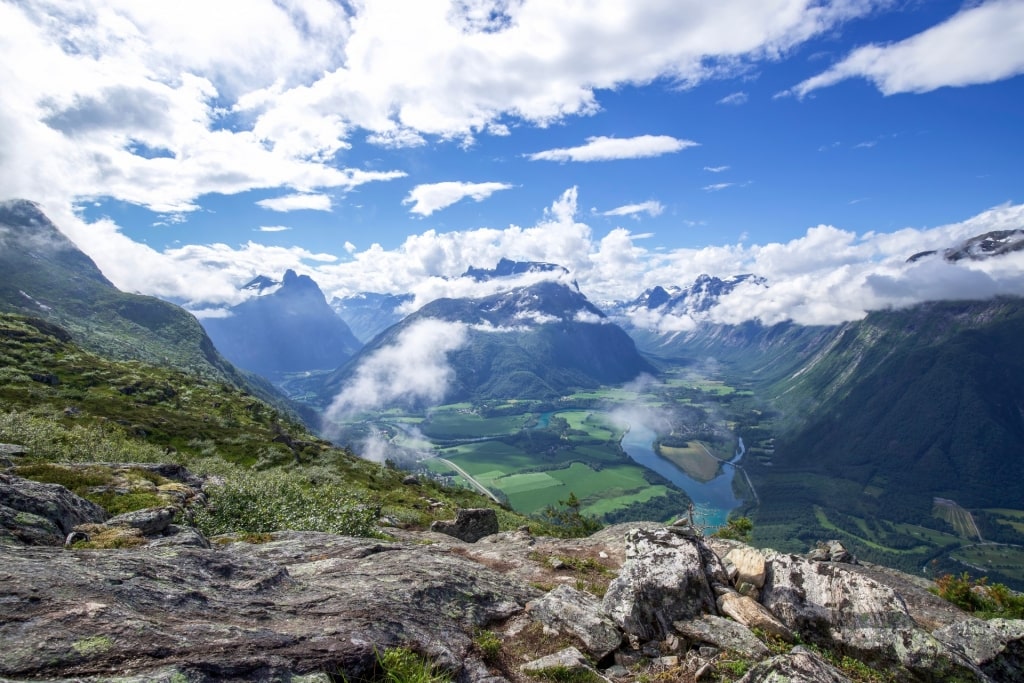
Mount Nesaksla
To get a bird’s-eye view of Romsdalsfjord, consider a hike to the top of Mount Nesaksla, rising 2,328 feet above Åndalsnes. Sections are fairly steep, though overall it’s a moderate-level hike. Notice the handiwork of Nepalese sherpas, who constructed the stone steps where the trail steepens.
A popular lookout point on Mount Nesaksla is Rampestreken. At 1,762 feet above sea level, the panoramas stretch across the fjord, into the valley, and over mountains. If you plan to tackle Nesaksla, carry plenty of water and wear hiking boots. You’ll want to set aside around three hours for the full hike.
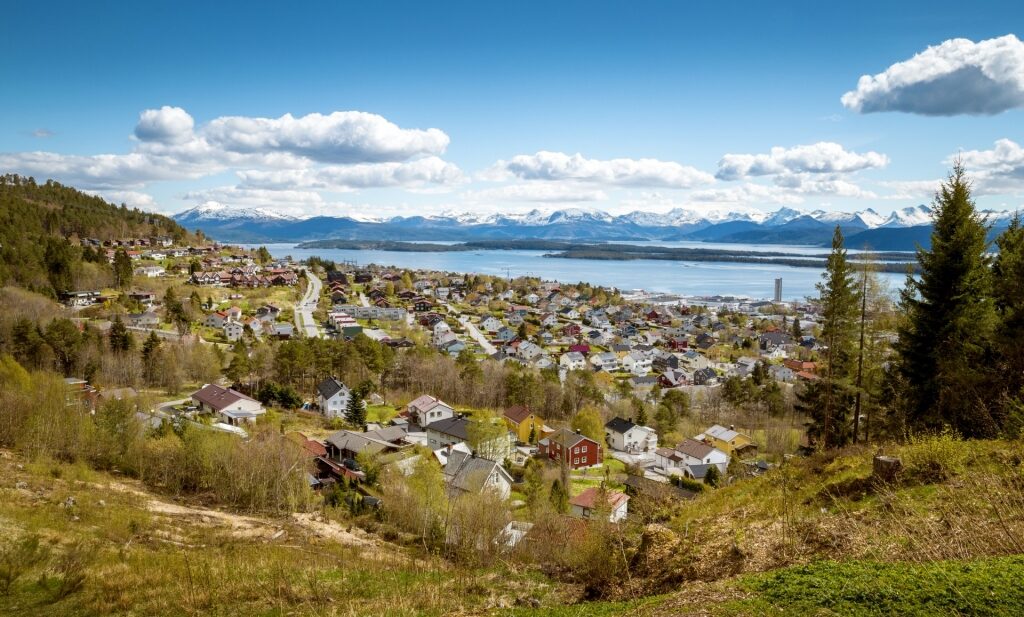
Molde
The Medieval city of Molde, lying on the Moldefjord, a limb of the Romsdalsfjord, has an immaculate harbor from where ferries dart across the fjord to Vestnes and Sekken island.
If you opt to spend time in Molde, visit the open-air Romsdal museum to explore the town’s centuries of history. Wander down Bygata, the main street of the museum, featuring traditional Nordic houses.
Sognefjord
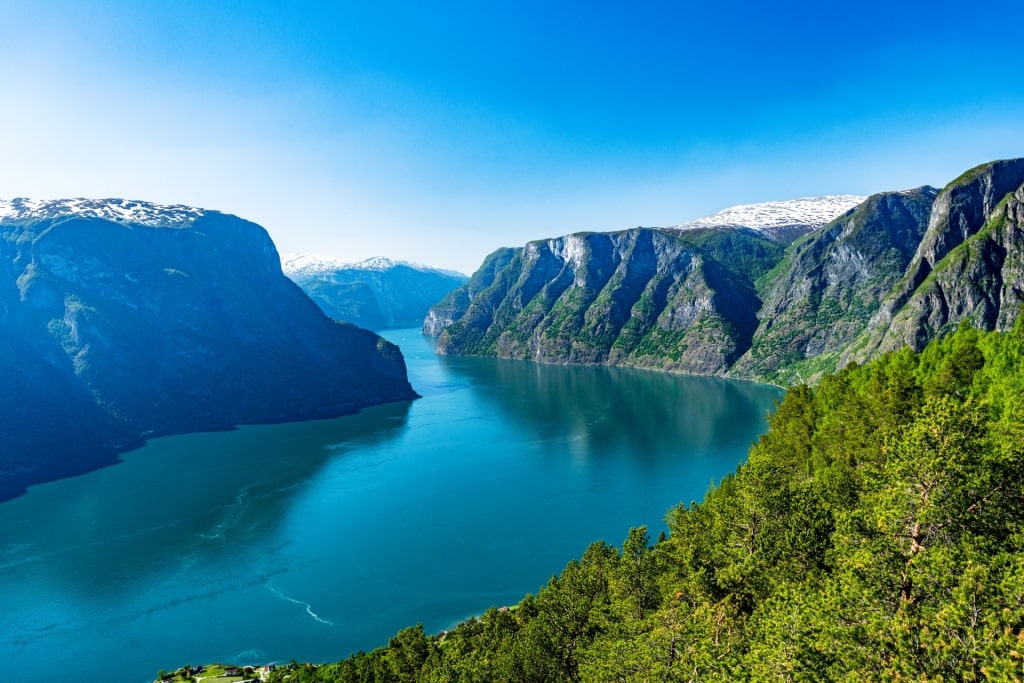
Sognefjord
The longest and deepest fjord in Norway is the snaking Sognefjord, lying midway between Måløy and Bergen on the west coast.
The Sognefjord winds a whopping 127 miles inland—with several offshoots, including the Nærøyfjord, Lustrafjorden, and Aurlandsfjord—to its furthest reaches in Skjolden.
The tricky-to-pronounce Fjærlandsfjord is a northern branch of the Sognefjord, where the water shimmers emerald green, reflecting the wild forests that surround it.
There’s a ferry service connecting the two sides of Fjærlandsfjord, from Vangsnes to Dragsvik and Hella at the entrance to the Fjærlandsfjord. The crossing takes around 15 minutes and operates year-round.
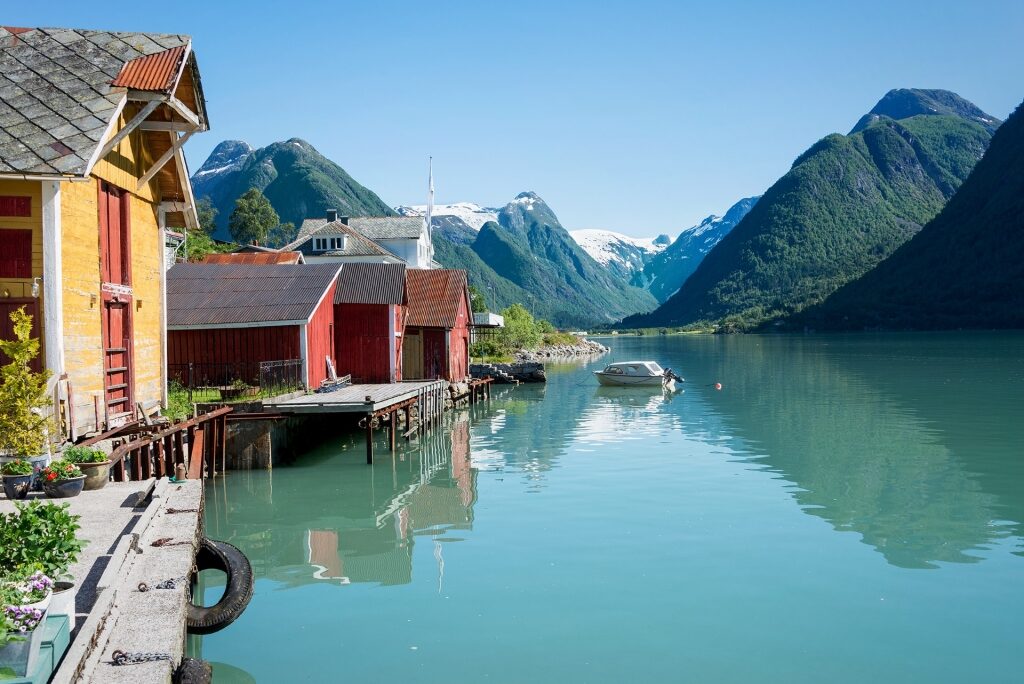
Mundal
Tucked into the Fjærlandsfjord, on the fjord’s west shore, is the little village of Mundal. It consists of no more than a couple of houses and guest lodges, but it makes for an attractive stopping point on either a boat or road trip around the Sognefjord.
Between May and September is the best time to visit, when guided kayak tours depart from Mundal, providing views of the nearby Bøyabreen and Flatbreen glaciers.
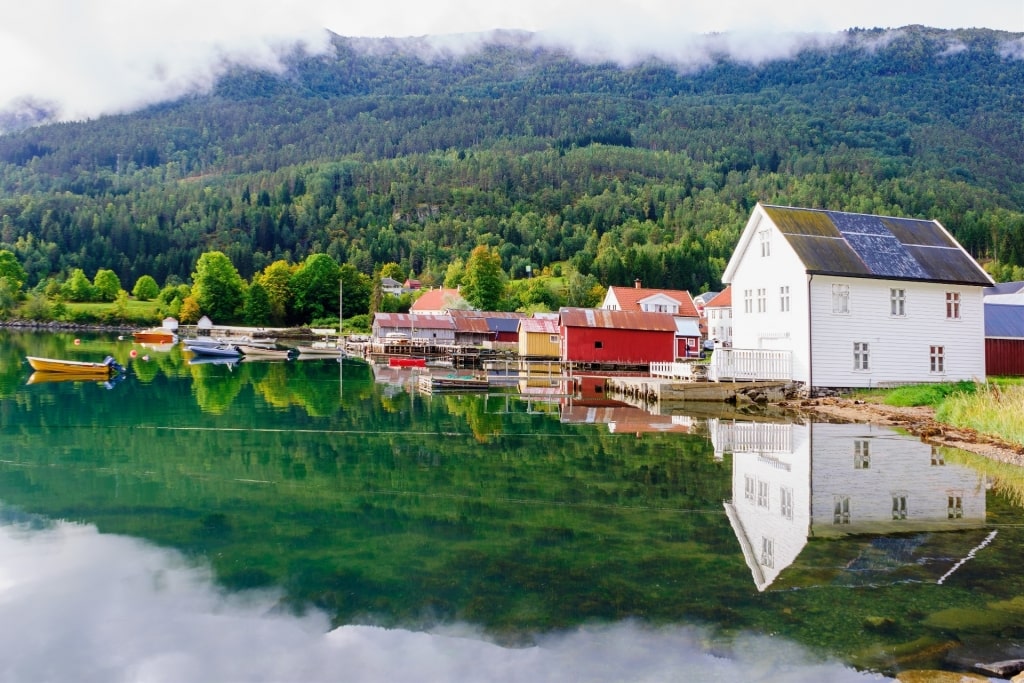
Solvorn
Solvorn, on the Lustrafjord arm of the Sognefjord, is another gorgeous spot with a picturebook harbor of white wooden houses hemmed in by picket fences.
There are a couple of cafés serving ice cream, cake, coffee, and other sweet and savory treats. Solvorn faces Urnes, with a 30-minute ferry service connecting the two villages during summer.
The 12th-century Urnes Stave Church is UNESCO-protected as one of the oldest stave churches in Norway. Explore the church’s fairytale-like architecture to see carvings on the north portal that predate the existing church.
Hjørundfjorden
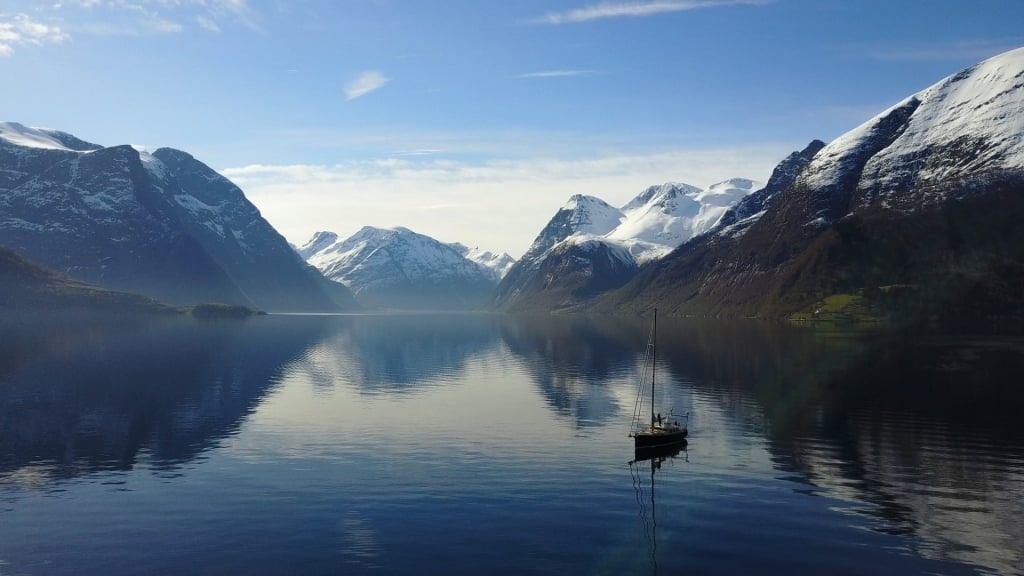
Hjørundfjorden
The majestic Hjørundfjorden lies south-southeast of Ålesund, branching off the sprawling Storfjorden. The sawtoothed Sunnmørsalpane mountains surround Hjørundfjorden, with peaks as tall as 5,600 feet rising up from the fjord.
One of the best ways to experience Hjørundfjorden is by boat from Solevagen, just south of Ålesund. Gaze at the beautiful mountain scenery as you sail along the 22-mile-long fjord before returning to Ålesund, famed for its art nouveau architecture.
Due to Hjørundfjorden’s steep landscape, there are very few villages on the fjord. This adds to Hjørundfjorden’s blissfully remote feel.
Oslofjord
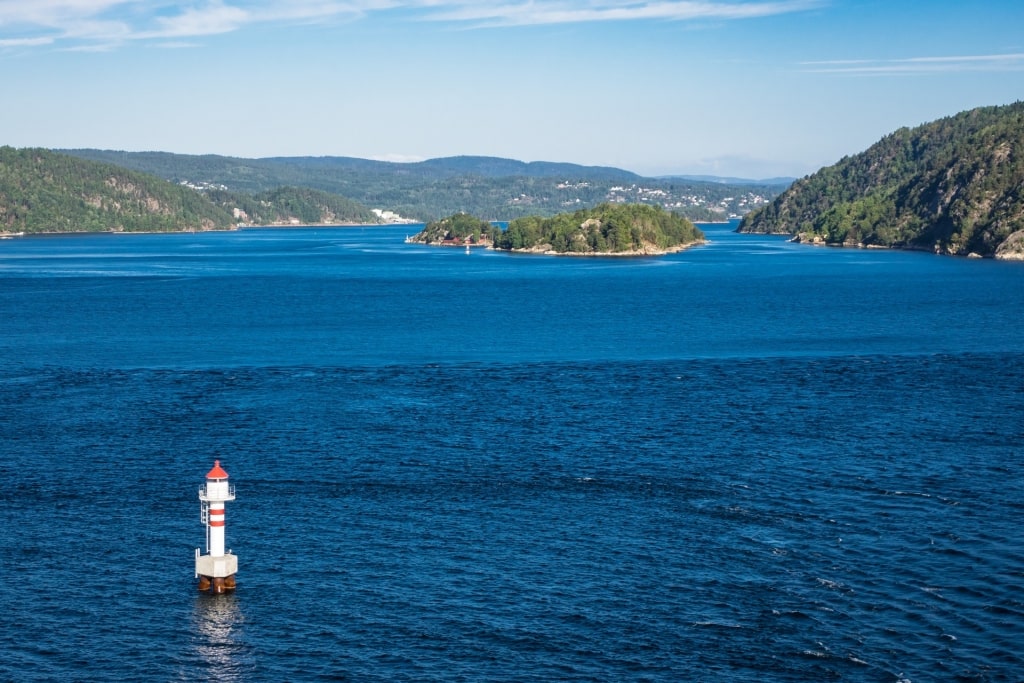
Oslofjord
While Norway is synonymous with fjords, the country’s capital city, Oslo, is more well-known for its fabulous museums and cosmopolitan restaurants, despite lying at the end of the Oslofjord.
The 62-mile-long fjord is dotted with idyllic islands and nature reserves. Oslo Ferries operate a service from Rådhusbrygga (the City Hall pier) to several of the inner fjord islands, including Hovedøya, Lindøya, and Nakholmen. Spend the day island-hopping to enjoy nature walks, beaches, and a fjord-side picnic.
Visitors don’t have to take the ferry to enjoy the Oslofjord, though. If you’re a fan of sea swimming, head for Sørenga Seawater Pool, with a beach, a children’s pool, and a diving platform.
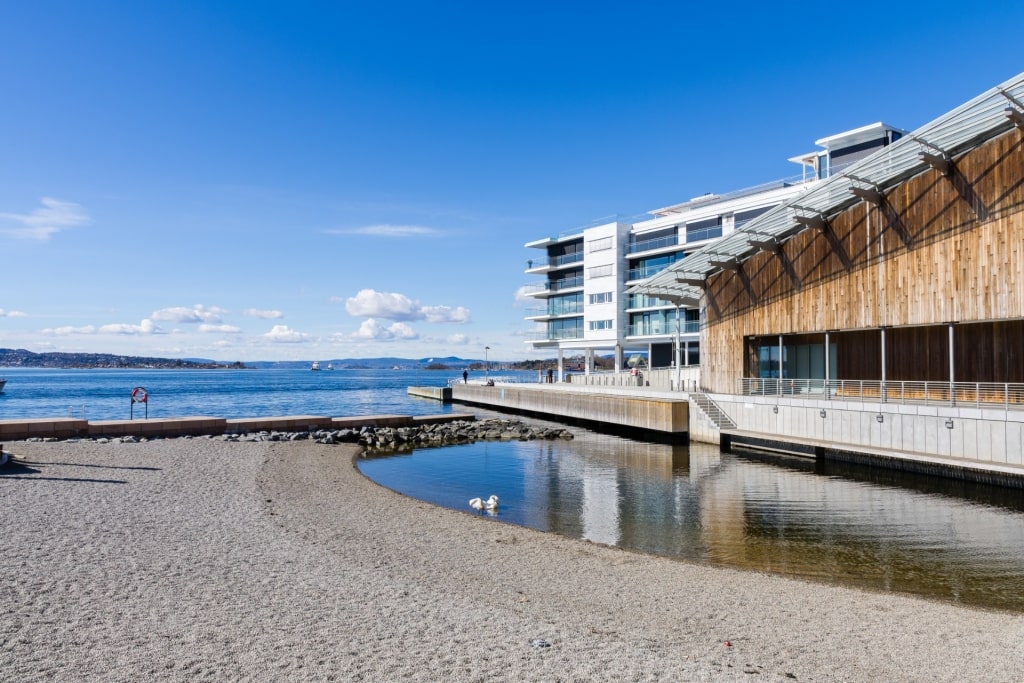
Astrup Fearnley Museum of Modern Art, Oslo
Right next to Oslo’s Astrup Fearnley Museum of Modern Art is the popular Tjuvholmen City Beach, one of the best beaches in Norway. Kayaking is popular, too, with regular tours departing from the nearby Sjølyst Marina.
One of the many great things about Oslo is the city’s walkability. Travelers can easily explore on foot, covering many of Oslo’s museums, including The National Museum and Munch, on the waterfront, while soaking up soothing fjord views.
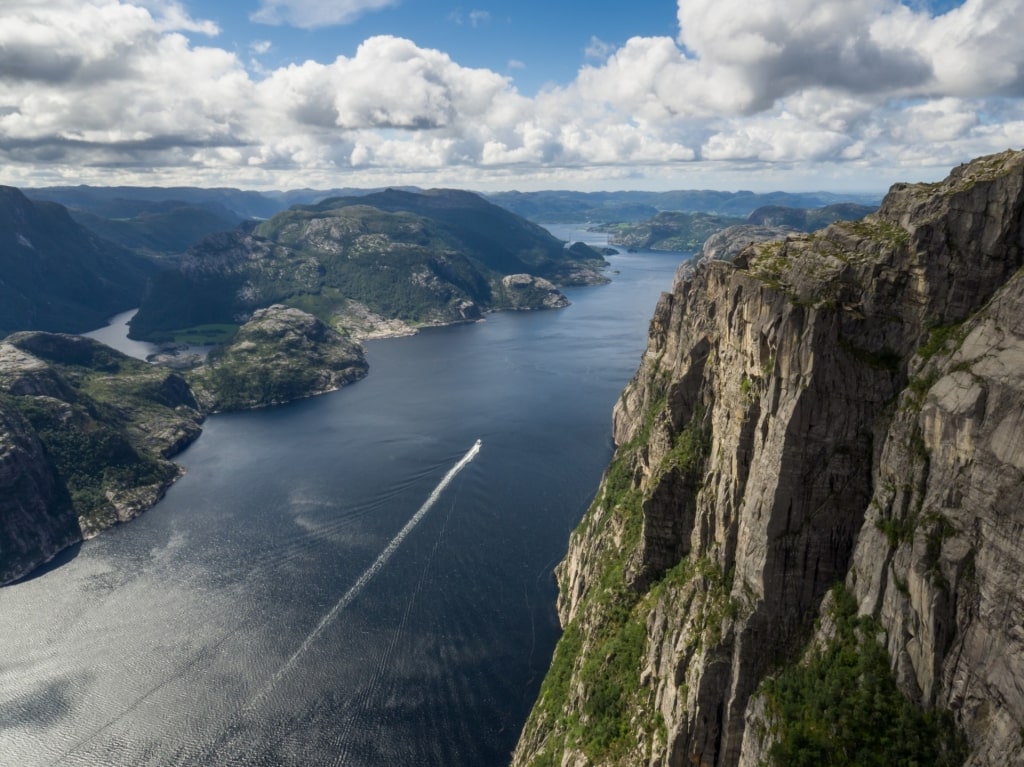
Lysefjord
With high mountains, deep fjords, and thundering waterfalls, Norway’s fjords are a nature lover’s dream. Discover our cruises to Norway and book your next unforgettable vacation.
